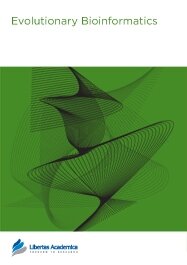

Publication Date: 12 Jun 2011
Type: Original Research
Journal: Evolutionary Bioinformatics
doi: 10.4137/EBO.S7084

The BRCT domain (BRCA1 C-terminal domain) is an important signaling and protein targeting motif in the DNA damage response system. The BRCT domain, which mainly occurs as a singleton (single BRCT) or tandem pair (double BRCT), contains a phosphate-binding pocket that can bind the phosphate from either the DNA end or a phosphopeptide. In this work, we performed a database search, phylogeny reconstruction, and phosphate-binding pocket comparison to analyze the functional evolution of the BRCT domain. We identified new BRCT-containing proteins in bacteria and eukaryotes, and found that the number of BRCT-containing proteins per genome is correlated with genome complexity. Phylogeny analyses revealed that there are two groups of single BRCT domains (sGroup I and sGroup II) and double BRCT domains (dGroup I and dGroup II). These four BRCT groups differ in their phosphate-binding pockets. In eukaryotes, the evolution of the BRCT domain can be divided into three phases. In the first phase, the sGroup I BRCT domain with the phosphate-binding pocket that can bind the phosphate of nicked DNA invaded eukaryotic genome. In the second phase, the phosphate-binding pocket changed from a DNA-binding type to a protein-binding type in sGroup II. The tandem duplication of sGroup II BRCT domain gave birth to double BRCT domain, from which two structurally and functionally distinct groups were evolved. The third phase is after the divergence between animals and plants. Both sGroup I and sGroup II BRCT domains originating in this phase lost the phosphate-binding pocket and many evolved protein-binding sites. Many dGroup I members were evolved in this stage but few dGroup II members were observed. The results further suggested that the BRCT domain expansion and functional change in eukaryote may be driven by the evolution of the DNA damage response system.
PDF (1.32 MB PDF FORMAT)
RIS citation (ENDNOTE, REFERENCE MANAGER, PROCITE, REFWORKS)
Supplementary Files 1 (7.90 MB ZIP FORMAT)
BibTex citation (BIBDESK, LATEX)
XML
PMC HTML
Publishing in Air, Soil and Water and Water Research was the best experience I have had so far in an academic context. The review process was fair, quick and efficient. I congratulate the team at Libertas Academica for a very well managed journal.Magnus Karlsson (IVL Swedish Environmental Research Institute, Stockholm, Sweden) What Your Colleagues Say
Copyright © 2012 Libertas Academica Ltd (except open access articles and accompanying metadata and supplementary files.)
FacebookGoogle+Twitter
PinterestTumblrYouTube